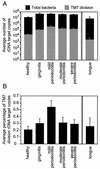Prevalence of bacteria of division TM7 in human subgingival plaque and their association with disease
- PMID: 12620860
- PMCID: PMC150096
- DOI: 10.1128/AEM.69.3.1687-1694.2003
Prevalence of bacteria of division TM7 in human subgingival plaque and their association with disease
Abstract
Members of the uncultivated bacterial division TM7 have been detected in the human mouth, but little information is available regarding their prevalence and diversity at this site. Human subgingival plaque samples from healthy sites and sites exhibiting various stages of periodontal disease were analyzed for the presence of TM7 bacteria. TM7 ribosomal DNA (rDNA) was found in 96% of the samples, and it accounted for approximately 0.3%, on average, of all bacterial rDNA in the samples as determined by real-time quantitative PCR. Two new phylotypes of this division were identified, and members of the division were found to exhibit filamentous morphology by fluorescence in situ hybridization. The abundance of TM7 rDNA relative to total bacterial rDNA was higher in sites with mild periodontitis (0.54% +/- 0.1%) than in either healthy sites (0.21% +/- 0.05%, P < 0.01) or sites with severe periodontitis (0.29% +/- 0.06%, P < 0.05). One division subgroup, the I025 phylotype, was detected in 1 of 18 healthy samples and 38 of 58 disease samples. These data suggest that this phylotype, and the TM7 bacterial division in general, may play a role in the multifactorial process leading to periodontitis.
Figures




References
-
- Chen, R. W., H. Piiparinen, M. Seppänen, P. Koskela, S. Sarna, and M. Lappalainen. 2001. Real-time PCR for detection and quantitation of hepatitis B virus DNA. J. Med. Virol. 65:250-256. - PubMed
-
- DeSoete, G. 1983. A least squares algorithm for fitting additive trees to proximity data. Psychometrika 48:621-626.
-
- Felsenstein, J. 1985. Confidence limits on phylogenies: an approach using the bootstrap. Evolution 39:783-791. - PubMed
Publication types
MeSH terms
Substances
Grants and funding
LinkOut - more resources
Full Text Sources
Other Literature Sources
Molecular Biology Databases

